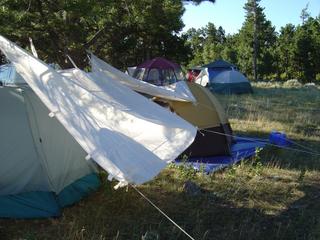Report from Rendezvous
So the goal of the tipi was to have a visible sign of "Camp Butchland", our entry in the "Butchest Campsite" contest at Rendezvous. The motivating vision was to have a Boy scout-like encampment.Here's our sign, made from a discarded roadsign picked up at a recycling center (Thanks Alex!) and decorated in electrical tape and black marker (Thanks Trish!)

We're not sure who we lost out to as we missed the camp awards part of Saturday's presentation, but we're pretty sure we didn't win. We were up against some stiff competition. At the very least, we need a catchier name to compete with "Beaver Creek" and "Bush Gardens".
Here's the tipi staked out at our campsite in Wyoming. The wind had an interesting effect on the tent... it moved the poles in. This photo was taken nearly 20 hours since I'd put it up, and the cover went from being taut to being this slack.

I elected to not sleep in the tipi, mostly because I was worried about bugs. So I did a test and left the door open on my dome tent to see what the bug and critter level was like. The result: not too bad. Of course, that's following the principle that food should be kept away from the sleeping area. We stored dry food in my car trunk and all other food in coolers in the kitchen area. While I spotted a few ground squirrels, we didn't have any in camp.
My parents had a set of tarp connectors in the early 70's that were made of a ball and a keyhole-shaped loop of wire. The tarp went over the ball, the tarp and the ball went through the round part of the loop, then the tarp and the ball were pulled into the smaller end. A guy rope was then tied to the round part and the other end of that staked out. Apparently, the traditional way to stake out a tipi was to use the same kind of setup around the cover. The cover then provides the opposition that keeps the tipi poles from collapsing.
I did something similar. This uses a practice golf ball (looks like a wiffle ball). The hank of rope has a slipknot around the ball and fabric and a non-slip knot in the other end. The other end is around the stakes. The sites I'm using as references call this a "pebble tie" and I'm going to go with that until I find or remember the other name.

My tipi blew over within 30 minutes of being put up without the pebble ties, but stood for over 24 hours in blustery Wyoming wind with them.
I also used the pebble ties to stake out the trailing ends of our shade canopy. Since these are two unused sides of an easy-up tent, the leading edge is the velcro ties of the tarp connected to a cable strung between the trees.


0 Comments:
Post a Comment
Subscribe to Post Comments [Atom]
<< Home